Sunday, 8 June 2014: Millau to Montpellier, the viaduct, and La Couvertoirade
Written 18 June
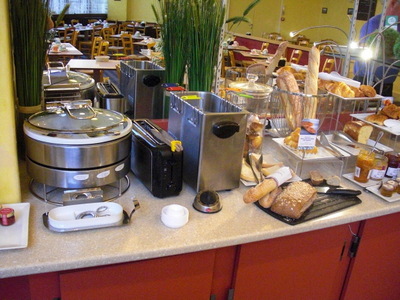
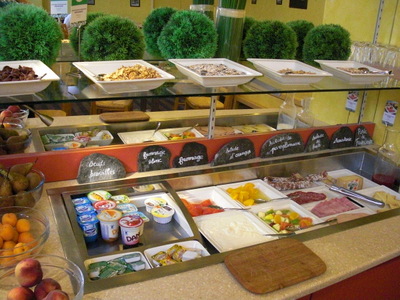 Breakfast at the Mercure was, indeed, more elaborate than at either Ibis Budget or full Ibis. And, fortunately, it was served in a separate dining room. The Germans had, in fact, come down in a body, and knowing that they would, and couldn't possibly all be accommodated in the Ibis Budget dining room, the management had partitioned off a section of the Mercure dining room for the overflow, and the breakfast clerk kept a sharp eye that none of them strayed around the partition to help himself from the Mercure buffet.
Breakfast at the Mercure was, indeed, more elaborate than at either Ibis Budget or full Ibis. And, fortunately, it was served in a separate dining room. The Germans had, in fact, come down in a body, and knowing that they would, and couldn't possibly all be accommodated in the Ibis Budget dining room, the management had partitioned off a section of the Mercure dining room for the overflow, and the breakfast clerk kept a sharp eye that none of them strayed around the partition to help himself from the Mercure buffet.
The left-hand photo shows a glass-topped chafing dish containing about a tablespoonful of very good scrambled eggs (which I ate and was never replaced) and pieces of excellent breakfast sausage. Then a toaster for sliced bread, then a hot water bath for boiling eggs (although I found no eggs). Then the various breads and cakes, jams and jellies.
At the right is the array of cold buffet items—cereals butter, yogurt, fromage blanc, cut fruit, three kinds of cold cuts and two of cheese. Also fresh whole fruit, including (finally!) apricots and peaches. Finally, on the glass shelf across the top, open dishes of several breakfast cereals. Just as I don't understand why the more expensive hotels provide shower gels and the cheaper ones bars of excellent soap, I don't see why the expensive places put their cereals out in open bowls to get stale while the cheaper ones keep them in more-or-less air-tight dispensers. Go figure.
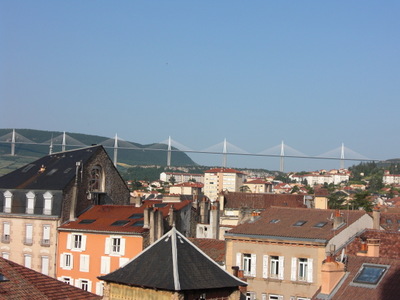
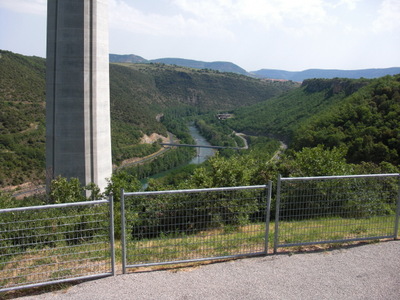 Now, the viaduct of Millau. Where to begin. This is the view of it from my hotel window, slightly telephotoed. Before it was opened in December of 2004, thousands upon thousands of French vacationers driving south by one of the country's three major north-south routes had to pass through the little town of Millau. The freeway brought them to the northern edge of the Tarn valley (shown at the right, with one of the viaduct's pylons in the foreground) and carried them away again from the southern edge, but to get from one to the other, they all had to leave the freeway, drive down the steep slope into the little town, through it, and up the other side to rejoin the freeway (and then back again the other way when vacation was over). The traffic jams were horrendous; sometimes the wait was over five hours!
Now, the viaduct of Millau. Where to begin. This is the view of it from my hotel window, slightly telephotoed. Before it was opened in December of 2004, thousands upon thousands of French vacationers driving south by one of the country's three major north-south routes had to pass through the little town of Millau. The freeway brought them to the northern edge of the Tarn valley (shown at the right, with one of the viaduct's pylons in the foreground) and carried them away again from the southern edge, but to get from one to the other, they all had to leave the freeway, drive down the steep slope into the little town, through it, and up the other side to rejoin the freeway (and then back again the other way when vacation was over). The traffic jams were horrendous; sometimes the wait was over five hours!
Many solutions were proposed, including running the freeway down the slope and back up the other side, but the grade was too steep, and the road cuts or tunnel necessary to ease the grade would have wrecked the aquifer for miles around. Once the decision was reached to build a viaduct, several companies advanced proposals, including solid concrete roadways, all-metal pylons, etc., but the winner was a multinational called Eiffage, which proposed reinforced concrete pylons and a hollow metal roadway and suspension towers. They put in 14 years of study before beginning, then built the whole thing in three years to the day, 5 weeks ahead of schedule, without a single death or injury worse than a broken arm. They fronted most of the money themselves, so they will retain ownership (and tolls, 7.30 euros per vehicle each way) for sixty or so years, before it reverts to the French government.
We got such a good start that we arrived at the visitors' center almost half an hour before it opened, so we parked on the roadside nearby, admired the view of the viaduct, took photos of flowers, and witnessed a strange phenomenon. As we sat in the car, reading our Kindles, a group of 10 or 15 motorcycles pulled up and parked around us. The spoke German among themselves, and one of them wore a bright yellow jacket with "tour guide" printed on the back! Apparently, they were on a motorcycle tour of France and stopped by to see the viaduct. They also admired and took photos, then mounted up and roared away again!
From the start, the viaduct has been called the "bridge of records" because so many were broken and reset during its construction. We'd already seen a French TV program about the process—an episode of C'est pas sorcier ("It's not magic," a little like Bill Nye the Science Guy)—the whole of which is absolutely mind-boggling.
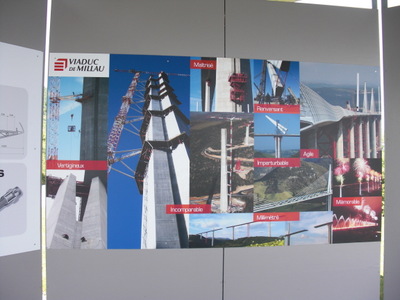
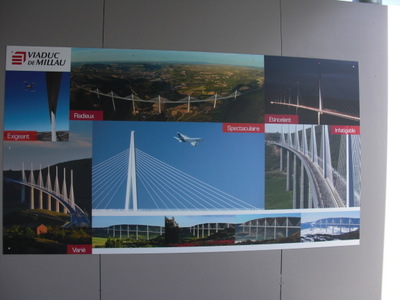 First, it's huge! These information panels are a little small in the photos, but I include them to show, at the left, the view from below of a pylon under construction with its dedicated tower crane, secured to it at intervals. The mechanism by which the crane could extend itself upward as the pylon grew was, to my mind, the second coolest thing about the whole project. I'm still thinking about whether I could actually describe it intelligibly to you, without the model they used on C'est pas sorcier. That panel also shows two views (one close up and one from farther back) of the pinacle (attachment point for the cables) being lifted into place above the top of one of the pylons.
First, it's huge! These information panels are a little small in the photos, but I include them to show, at the left, the view from below of a pylon under construction with its dedicated tower crane, secured to it at intervals. The mechanism by which the crane could extend itself upward as the pylon grew was, to my mind, the second coolest thing about the whole project. I'm still thinking about whether I could actually describe it intelligibly to you, without the model they used on C'est pas sorcier. That panel also shows two views (one close up and one from farther back) of the pinacle (attachment point for the cables) being lifted into place above the top of one of the pylons.
The right-hand panel is just a montage of views of the finished viaduct, showing (in fact, exaggerating) its slight curve.
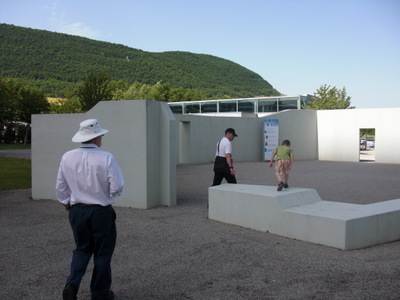
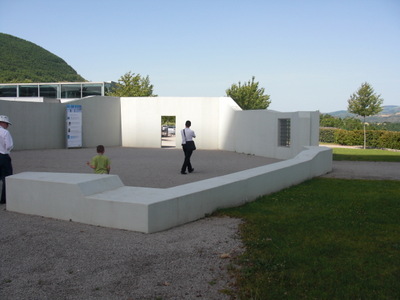 After thoroughly exploring the indoor exhibits (no photography allowed) and watching a movie montage of scenes from the contruction process, we followed our guide out into the outdoor area. Here, at left and right, are views of the footprint of a pylon, laid out so that you can walk through it and get an idea of its scale. In the right-hand view, at the right-hand side, they've left a window in the concrete so that you can see the latticework of rebar embedded in the wall. The area inside the foot of the largest pylon (#2, the tallest ever built) is the size of a tennis court.
After thoroughly exploring the indoor exhibits (no photography allowed) and watching a movie montage of scenes from the contruction process, we followed our guide out into the outdoor area. Here, at left and right, are views of the footprint of a pylon, laid out so that you can walk through it and get an idea of its scale. In the right-hand view, at the right-hand side, they've left a window in the concrete so that you can see the latticework of rebar embedded in the wall. The area inside the foot of the largest pylon (#2, the tallest ever built) is the size of a tennis court.
The little kid in the green shirt (maybe five years old) was full of questions for the guide. At this point, we were standing essentially under the viaduct, and at the very first stop on the tour, he asked the guide what are those little holes up there near the top. The guide was astonished, saying that that was probably the most technical question he was likely to get all day! But he knew the answer. He explained that, rather than painting the interior of the metal roadbed (called the "tablier," the apron, in French), Eiffage had devised a system for keeping its interior humidity so low that rust was not a problem. Those holes in the underside of the roadbed were the evacuation ports for that system. No, said the kid, not those holes. I meant the ones near the top on the sides of the pylons! The guide new that answer, too. They were attachment points for supports in case a maintenance platform had to be set up for work on the underside of the roadbed.
A French lady asked how they kept birds of prey from nesting in the openings. The answer was that they don't. They just let 'em nest there. It's all watertight, and the nests cause no problem, but they might have to be evicted if they were unlucky enough to be nesting when the holes needed to be put to use.
That brought up the question of routine maintenance. The whole thing has to be repainted every seven years (it takes 7–8 months), so Eiffage built a special truck that travels along the breakdown lane and extends a long articulated arm out over the edge and back underneath. Technicians work on a platform at the end of that arm, first sandblasting the old paint off then spraying the new coat on.
The watertightness of pylon surfaces is really important, because only about 4 cm of concrete covers the embedded rebar. If water ever gets in through a crack and reaches the rebar, rust sets in, and rusts expands. Not good at all. Therefore, at frequent intervals, technicians climb down inside the pylons, from the roadbed, and go down ladders inside, taking high-resolution photos all the way down, which are later meticulously examined in the lab in a search for breaches. The technicians then exit through doors at the bottoms of the pylon. As the guide pointed out, it's really important to remember the key to that door; otherwise you'd have to climb all the way back up to get out! They used to hire mountaineers to rappel down the outsides of the pylons taking inspection photos, but now they use little helicopter drones instead.
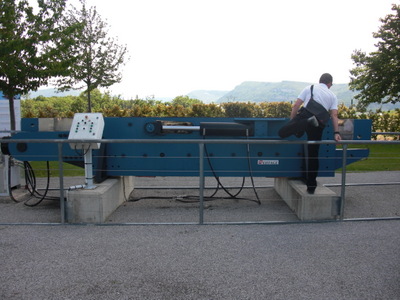
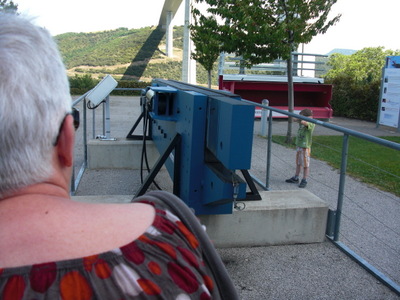 The coolest thing about the construction, though, was the way in which the roadbed was laid. Once the pylons were built (all seven were built simultaneously, to save time), additional, temporary metal pylons (the largest ever built) were erected between them to support the roadbed across the long spans until the suspension cables were installed. The one place where they couldn't put a temporary pylon was between pylons 2 and 3, because it would have had to stand in the river, so that was the point at which the two ends, advancing from opposite sides of the valley, had to meet, in mid air. But the truly cool thing is how the two ends were advanced. Eiffage is too good an employer to ask its welders to work out over the void, attaching each roadbed section to the previous projecting one. Instead, they attached each new section at the landward end, on terra firma, then pushed the entire roadbed so far assembled out over the void before attaching the next section at the landward end!
The coolest thing about the construction, though, was the way in which the roadbed was laid. Once the pylons were built (all seven were built simultaneously, to save time), additional, temporary metal pylons (the largest ever built) were erected between them to support the roadbed across the long spans until the suspension cables were installed. The one place where they couldn't put a temporary pylon was between pylons 2 and 3, because it would have had to stand in the river, so that was the point at which the two ends, advancing from opposite sides of the valley, had to meet, in mid air. But the truly cool thing is how the two ends were advanced. Eiffage is too good an employer to ask its welders to work out over the void, attaching each roadbed section to the previous projecting one. Instead, they attached each new section at the landward end, on terra firma, then pushed the entire roadbed so far assembled out over the void before attaching the next section at the landward end!
The mechanism that made that incredibly improbable maneuver possible is the "translateur" (which, in French, means not "translator" but "sideways mover"). The left and right photos here are two views of a real, operational one mounted at ground level for demonstration purposes (at the left, that's our guide climbing over the guardrail to conduct the demonstration). Unfortunately, it's not a cutaway, like the model on C'est pas sorcier, so you can't see all its workings. Inside, sandwiched between the sides of the mechanism, are two metal right triangles, hypotenuses together. As you can see in the right-hand photo, the long horizontal side of the upper triangle sits just below the level of the two sides of the mechanism. In use, the roadway rested on those two sides. To move it forward 60 cm, a hydraulic arm (you can see the shiny metal piston in the left-hand photo) slowly pushed the upper triangle forward. Its hypotenuse slid up the hypotenuse of the lower triangle, causing the long horizontal side to rise up to take the weight of the roadbed, lift it a centimeter or two above the sides, and carry it forward. Then the upper triangle stopped and the lower triangle slid forward, slowly allowing the upper triangle to settle back downward and lay the roadbed gently back onto the supporting sides, but 60 cm forward of its previous position. Once the two triangles were again maximally overlapping, and the upper edge of the upper triangle was no longer in contract with the roadbed, both triangles were slid backward to their original position so that the cycle could begin again. Each time a section of roadbed was attached at the landward end, the translateurs (one on each pylon and one on each temporary pylon, cycled continuously for 48 hours, moving the whole roadbed forward in 60-cm increments, until it had advanced the whole length of the section, all with zero friction between the roadbed and the pylons. Ingenious! A computer controlled all the translateurs, to ensure that they worked in perfect synchrony.
When the two ends of the roadbed met, between pylons 2 and 3, the design could tolerate a couple of feet of vertical displacement, but the horizontal displacement between the two ends couldn't exceed about 4 cm. Eiffage made a special arrangement with the U.S. military to rent its superaccurate GPS to ensure the two ends met. They did, and the film montage showed a bottle of champagne exploding between the two as the translateurs did that last push forward.
Each roadbed section consists of a central core (including a hollow corridor down the center that's 4 m tall) and two flanking sections carrying the breakdown lanes, railings, and baffles. They were fabricated in special factories built for the purpose and trucked to the site for assembly. Eiffage also built a dedicated factory to produce the concrete for the pylons, which had to be not only all exactly the same color but exactly the right color, chosen to harmonize with the landscape.
Miscellaneous additional information: It took 2 million hours of work, 96% of it on the ground; 14 authorized lift operators; 3000 construction workers; 19 crane operators; 350 welders; 150 engineers. The workers were of 15 nationalities (mostly European) and 19 building trades. Using a metal rather than a concrete roadbed saved 5000 truck trips; construction noise was held below 65 decibels at all times. Two environmental engineers were on site full time. The 350,000 m3 of excavated dirt (the foundation of each pylon extends down through the soil to bedrock) were saved and reused in the restoration of the landscape under the viaduct once it was finished. Rainwater that falls on the roadway is recovered and filtered before being returned to nature. Over 60 km of cabling and fiberoptic lines run in the viaduct.
The structure is built to withstand wind gusts up to 240 km/hr. Seven lightning rods (one on each pinnacle) protect it during thunderstorms. The viaduct would be closed if sustained winds reached 140 km, but so far that's never happened. Seismic sensors monitor for tremors; at the slightest sign of earthquake, barriers at both ends immediately stop traffic from entering. Because, at highway speeds, transit time over the viaduct is only a little over 2 min, even cars already on it have a good chance of getting off before the main quake hits. The structure uses 4000 kwh daily; two generators cut in to keep everything functioning in case of power failure. It's surrounded by a 300-m no-fly zone. The whole thing is under 24/7 video surveillance, in addition to 11 in-person patrols per day. Average response time to distress calls is 7 min.
The highest point (the top of the pinnacle on pylon 2) is 343 m above ground. Each span between pylons is 342 m long. The longest cable is 180 m long and weighs 25 tons. Expansion of the roadbed in hot weather has pushed the first and last pylons as much as 40 cm apart, but the structure is built to take up to a meter.
Once the whole thing was finished, the roadbed paved, the toll-booth built, etc., a final test was done—28 very large, fully loaded dumptrucks were driven onto one of the spans (more weight than could possibly be placed there during ordinary use), 7 in each of the four lanes, and parked, bumper to bumper. (They covered the loads with matching blue canvass and aligned them very carefully, for the best possible aerial photograph.) Downward displacement of the center of the span leveled out at about 4 cm, and the deformation disappeared again promptly when the trucks were driven off again. The structure was declared safe, and the inauguration took place on 14 December 2004 (much more champagne was smashed). The roadway wasn't opened to the public until 16 December, though, to give Eiffage's entire worldwide workforce time to recover from their hangovers after the office party. I asked our guide, who was wearing an Eiffage logo shirt, whether he was at the party, but he said that, no, he lived in Millau during the construction, working as a tour guide in a nearby Medieval chateau, but he only joined the company when they opened the visitors' center and needed tour guides. We also asked how they determined who got to drive over it first; the answer was simply that it was the first guy in line at the toll booth that morning. They don't know how long he'd been waiting.
At the end of the tour we were given a souvenir brochure that includes a great graphic comparing the heights of the various spans to famous structures around the world. If the Eiffel Tower stood spanning the Tarn, between pylons 2 and 3, its head would appear above the roadway but far below the tops of the pinnacles.
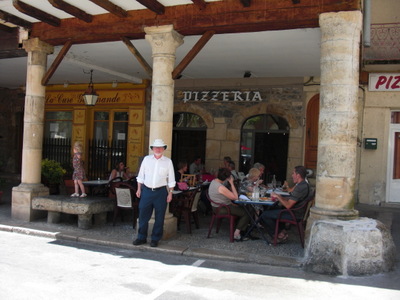
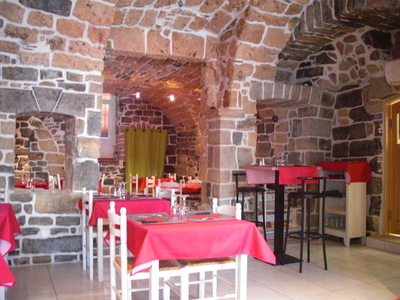 We were, at this point, thoroughly wowed and mindboggled, and it was time for lunch. Our drive back to Millau was complicated (as was our trip out of it, earlier) by a huge street festival (celebrating the bicycle) that was occupying the town's central street rotary, a couple of blocks from our hotel, which (of course) the GPS didn't know about. To get out of town, we'd bushwhacked northward to the river and crossed it before paying any attention to the GPS, which at that point had recalculated the route that didn't lead through town. Going back, we just retraced our route, then turned cautiously inward toward the middle of things, but not too far, looking for parking (helpfully marked on our little paper city map). A few minutes' walking led us to the Place Maréchal Foch (Foch, pronounced "fawsh," is another of those guys with a something named after him in every town) and this little pizzeria under a historic arcade.
We were, at this point, thoroughly wowed and mindboggled, and it was time for lunch. Our drive back to Millau was complicated (as was our trip out of it, earlier) by a huge street festival (celebrating the bicycle) that was occupying the town's central street rotary, a couple of blocks from our hotel, which (of course) the GPS didn't know about. To get out of town, we'd bushwhacked northward to the river and crossed it before paying any attention to the GPS, which at that point had recalculated the route that didn't lead through town. Going back, we just retraced our route, then turned cautiously inward toward the middle of things, but not too far, looking for parking (helpfully marked on our little paper city map). A few minutes' walking led us to the Place Maréchal Foch (Foch, pronounced "fawsh," is another of those guys with a something named after him in every town) and this little pizzeria under a historic arcade.
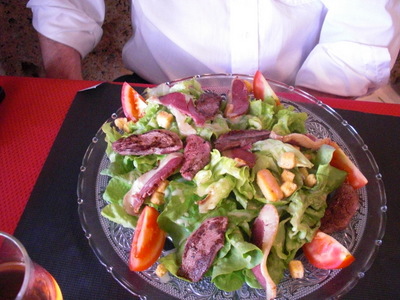
 David got a salad as usual (this one with duck breast ham, sautéed fresh duck breast strips, and croutons).
David got a salad as usual (this one with duck breast ham, sautéed fresh duck breast strips, and croutons).
The pizzas on the menu were divided into tomato-based and cream-based. I ordered an "Alsatian," from the cream-based side, which was an excellent take on a flammeküche, a very thin, crispy crust topped with cream, lardons, onions, and cheese. I can't believe I ate the whole thing!
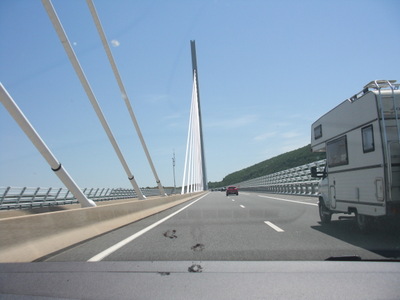
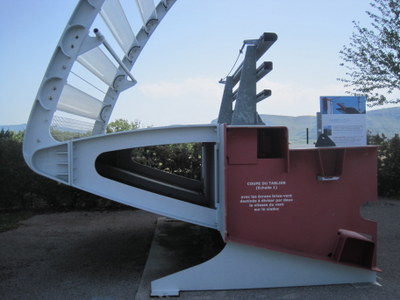 Our work in Millau was almost done (though I would have liked to visit the museum of glove making). All that remained was actually to drive over the viaduct! That's not as easy as it sounds, from Millau. You have to drive a ways north of town to pick up the freeway, and the next chance to get on or off it is much farther south of town. We therefore set the GPS to take us to Cahors, as the easiest way to get it to direct us to the next chance to get onto the freeway. (It worked like a charm, although later, when we wanted to go to Montpellier, we had a little trouble pursuading it that we didn't want to go there via Cahors.)
Our work in Millau was almost done (though I would have liked to visit the museum of glove making). All that remained was actually to drive over the viaduct! That's not as easy as it sounds, from Millau. You have to drive a ways north of town to pick up the freeway, and the next chance to get on or off it is much farther south of town. We therefore set the GPS to take us to Cahors, as the easiest way to get it to direct us to the next chance to get onto the freeway. (It worked like a charm, although later, when we wanted to go to Montpellier, we had a little trouble pursuading it that we didn't want to go there via Cahors.)
The photo at the right shows the visitors' center's life-size cross section of the flnaking portion of the roadbed, carrying the breakdown lane, a stout railing, a safety lane, and then the tall plexiglas wind baffles (designed to reduce wind speed by 50%). The idea is that, if your car breaks down, you pull off onto the breakdown lane, then climb through the railing to the safety lane (apparently, Eiffage calculates that the life expectancy of a person standing around in the breakdown lane of a freeway is between 10 and 20 minutes, so they wanted to provide a safe place to wait for help (and to get away from your car, if it is, for example, in flames). The viaduct is not open to pedestrians; stout gates and barriers block access to the safety lane at each end.
People being what they are, the management has constant problems with "base jumpers" (actually, B.A.S.E. jumpers; it's an acronym), i.e., people who want to jump off the bridge with parachutes. Here's the drill. The jumper and a confederate pay the toll and drive onto the viaduct from the north, in a car with fake or stolen number plates (because of all the surveillance cameras). They stop at the chosen point (usually the highest spot, between pylons 2 and 3; the jumper gets out, and the confederate high-tails it south, where there's no toll booth to slow him down. The jumper scales the wind baffle and jumps. Down below, another confederate is waiting on the little road next to the river to pick the jumper up and high-tail it (rather more slowly and bumpily) for parts unknown. They get away with it a lot, as the 7-minute mean response time is public knowledge. They often catch the jumpers, but they can't arrest them because, as it happens, jumping off bridges is not illegal in France. On the other hand, except in cases of emergency, stopping your car on the Millau viaduct is illegal, so the driver, if caught, is liable to a fine. What I wonder is how and where they ditch the fake number plates, as there's no exit from the freeway for a good ways south of the viaduct; I guess they pull over into the breakdown lane once they're clear of the viaduct's cameras. No mention was made of suicides, and I didn't ask (not in front of the little kid in the green shirt), but they must be a problem as well.
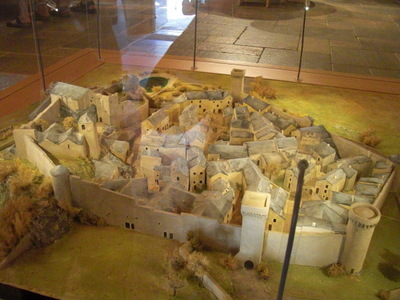
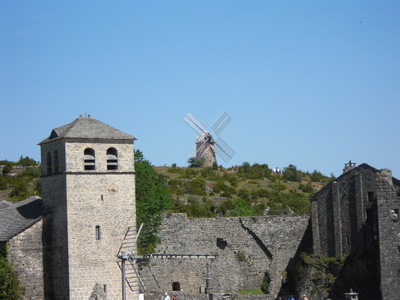 When we signed up for our Roquefort cave tour, we chatted with the cashier, and when he heard we were on our way to Montpellier via Millau, he warmly recommended a fortified village built by the Knights Templar and called La Couvertoirade. Just off the freeway, he said, and even told us the exit number.
When we signed up for our Roquefort cave tour, we chatted with the cashier, and when he heard we were on our way to Montpellier via Millau, he warmly recommended a fortified village built by the Knights Templar and called La Couvertoirade. Just off the freeway, he said, and even told us the exit number.
That sounded good, and we had time, so we decided to stop. As promised, it was only about 5 km from the freeway, but to get there, you had to leave the freeway 10 km before it, then continue 5 km beyond it to get back on. Not a problem though, as the drive was quite scenic.
As you can see from the scale model, on display in the Office de Tourism, it's not very big but very Medieval. It was built, like everything else historic in France, in the 12th century. Unusually, it was built on a site with no water source—because somebody gave the land to the Templars; they didn't pick it out themselves. Until the 1960's the only source of water was still cisterns filled with rainwater. It only has about 30 year-round residents now, but some of the houses are occupied seasonally.
We started with the film at the Office de Tourisme, which was a series of profiles of permanent residents, including a baker, a couple and their 10-year-old daughter who keep sheep (and who, just as local shepherds have for centuries, still drive their flock to the waterhole morning and evening; they only chance they have to drink), a lady who spins and weaves raw wool, and some artists.
The windmill up on the hill behind the village was a ruin until recently but has now been restored to working order. Soon, they hope to begin making flour again. You could walk up to it by a steep path, but we declined the invitation.
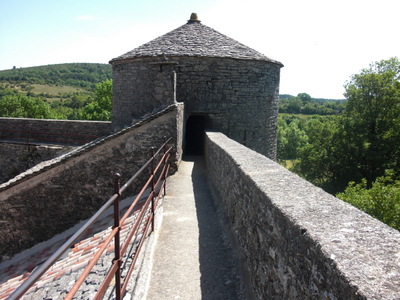
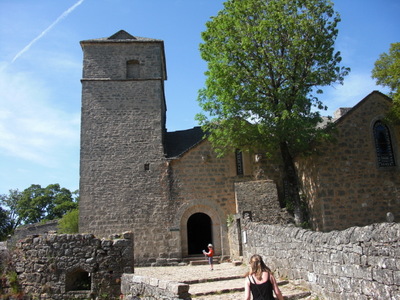 After the movie, we climbed the tower above the Office de Tourisme (the light-colored square one nearest the camera in the model; the little archway at the bottom of it is the gate we entered through, and the Office de Tourisme on the right just inside) to reach the ramparts. You can't walk all the way around, but you can do a little more than half of the distance.
After the movie, we climbed the tower above the Office de Tourisme (the light-colored square one nearest the camera in the model; the little archway at the bottom of it is the gate we entered through, and the Office de Tourisme on the right just inside) to reach the ramparts. You can't walk all the way around, but you can do a little more than half of the distance.
The round tower in the left-hand photo is the pigeon-cote; pigeons were confined there because no one wanted them flying around loose when the town depended for its water on rainfall running off the rooftops!
After the ramparts, we followed the leaflet provided with our audioguides, listening to information about the various buildings and periods of history. At the right is the templars' chapel.
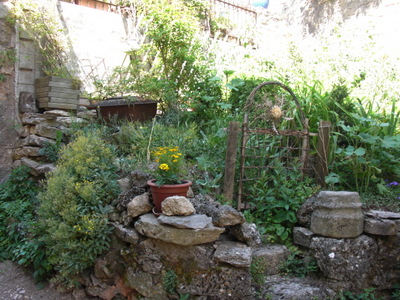
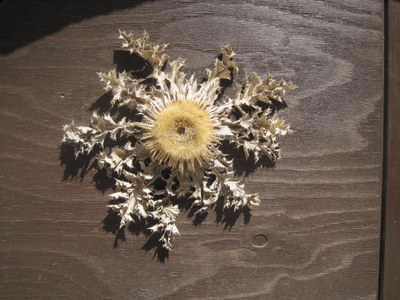 The occupant of one house was cultivating the spectacular terraced garden in adjacent ruins. I think it was actually the garden of the spinner/weaver from the movie, who mentioned that, when she washed raw fleeces, she reused the water several times and then watered her garden with it.
The occupant of one house was cultivating the spectacular terraced garden in adjacent ruins. I think it was actually the garden of the spinner/weaver from the movie, who mentioned that, when she washed raw fleeces, she reused the water several times and then watered her garden with it.
On the garden's arched gate, you can see (if you look really closely) a decorative dried thistle. At the right is a better picture of one, which David found on a door elsewhere in the village. Several of the houses had them. I understand they're good luck and are supposed to ward off both lightning and noctural evil spirits by giving the impression that the sun is shining.
Definitely a worthwhile stop. Thanks, Mr. Société ticket-seller guy!
Once back on the freeway, we just headed for Montpellier, through some spectacular scenery and down some really impressive grades (6–7% on a freeway!; escape lanes for runaway trucks every few kilometers). We had hte address of our hotel, so we just set the GPS for it and hoped for the best. I didn't think they had parking, but maybe they could recommend something.
All went well until we actually reached the vicinity of the hotel in downtown Montpellier.. We missed a turn because we couldn't get into the right lane, and then missed the next because by the time the GPS could recalculate the route, the turn has already passed. We repeated this process several times, with the GPS in total recalculation meltdown because it couldn't think fast enough to get us on a workable route before that route was no longer workable! Once, it directed us onto trolley tracks, and twice tried to make us turn the wrong way on one-way streets. After making a couple of loops, we found a place to pull over to let it get its act together, studied the overview of the route, then followed it very, very slowly through the maze of tiny one-way streets so that it could keep up, and followed its directions right into an abrupt cul-de-sac. The street simply ended where it met the edge of the large open Place de la Comédie, blocked by a row of huge concrete planters with trees in them. To get out of there, we had to back up for almost a block between two rows of parked cars and bicycles. Before we could turn around, which we couldn't do anyway, because the street was one-way. So we drove off in the one permitted direction (the intersecting street was one-way too) and were back in the maze. The GPS was useless, because it kept trying to direct us back to the cul-de-sac.
Finally, after a frustrating 45 min getting no closer, we parked (a good ways away, as everything closer was parked up), David stayed with the car, and I hiked to the hotel, which wasn't easy, either, because the only maps I had were a Google area map and the Montpellier inset of our large Michelin map, either of which showed all the streets (many of which weren't labeled anyway) and which chose to show different subsets of them. I finally got there, after about 20 min (in a pedestrians-only zone off the Place de la Comédie; why didn't the GPS know it was a pedestrian street? It warned us that our hotel in Perpignan was unreachable . . .), ground my teeth for another five while the desk clerk tried to find our reservation, and asked where we should park. The clerk and his superior were unanimous that we should park in the Comédie's underground garage, the entrance to which was was itself in a tunnel, which you had to enter from the right end. Just enter it into your GPS, they said, piece of cake. They didn't believe me when I insisted that our GPS didn't know Montpellier's traffic pattern or recognize its pedestrian zones, but they gave me a better map, and I made them outline the route on it anyway.
Getting back to the car took only about 10 min. Sure enough, the GPS claimed to know where the parking garage was, but when we started following its directions, things looked awfully familiar—it was trying to take us there via the cul-de-sac again. So we made a u-turn and drove away from the Place until it recalculated a route that seemed to correspond to the big round-about loop the hotel folks had recommended. At that point, it began directing us correctly and actually got us there, though that tunnel was pretty scary—high-speed traffic, a million orange cones closing off lanes, other streams of traffic arriving and leaving through side tunnels—but once we were into the garage things were fine. It was even one of those, rare in France, that didn't put a pillar every two spaces. Then we just had to wheel all our luggage through the garage to the elevator, up to the all-pedestrian Place de la Comédie, and a quarter-mile across it to our pedestrian street, and eventually our hotel. (At one point, the next day, in crossing the place, we encountered a small car, in which a couple of bewildered tourists were driving very carefully through the crowds of pedestrians on a diagonal line across the place, which is probably three times the size of a football field; aha, we thought, same brand of GPS we're using.)
The hotel turned out to be okay, once we were finally there and installed, although its showers were not the best of the trip. By that time, it was 8:30 p.m., and we were starved. It was Sunday, and we didn't have reservations anywhere, but I had verified before we left Millau that the Hippopotamus Grill was (a) open and (b) within walking distance, so we at least had a fall-back plan. After reading half a dozen menus in and around the place, though, we just settled for l'Assiette aux Boeuf (the Beef Plate) a chain steak place.
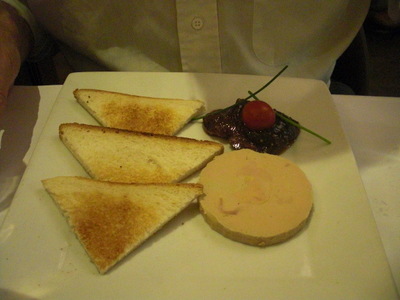
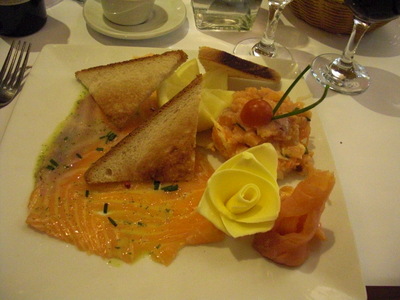
First course, David: Foie gras with toasts and fig jam. David has discovered a real fondness for fig jam on this trip, especially as an accompaniment to cheeses. Fortunately, I've got lots of frozen home-grown figs in the freezer at home.
First course, me: Salmon three ways. At the left, marinated raw; at 2 o'clock, tartare on a bed of cabbage slaw; at 4 o'clock, a little turban of smoked. Lemon half in the back. The yellow rose is made of thin slices of butter! I saw no point to butter with any of those treatments of salmon, but I transferred iot to a piece of toast and kept it for use with the bread that came with the main course.
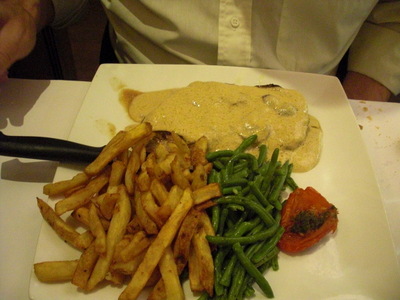
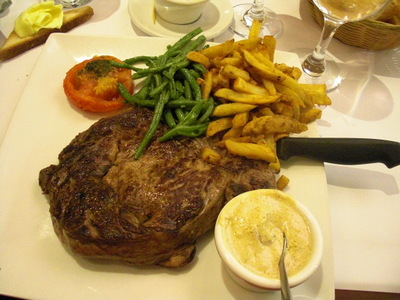 Main course, David: Excellent veal cutlet with "forestière" (i.e., cream and mushroom) sauce, fries, quite good green beans, and a roasted tomato.
Main course, David: Excellent veal cutlet with "forestière" (i.e., cream and mushroom) sauce, fries, quite good green beans, and a roasted tomato.
Main course, me: Entrecôte of beef (specified on the menu as weighing 350 g). I had my choice of sauces with it, and as they didn't have Béarnaise, I also chose forestière. Same side dishes. This entrecôte was actually a better cut than the one in Perpignan, with a much larger portion of the spinalis dorsalis muscle (my favorite), but it was also 2/3 the size of the one in Perpignan, which was for two! I couldn't finish it, but it was very, very good.
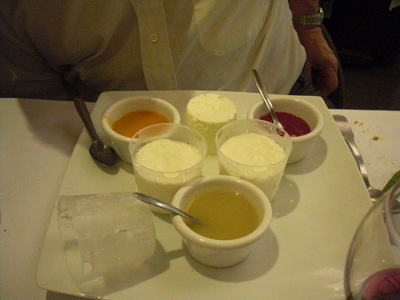
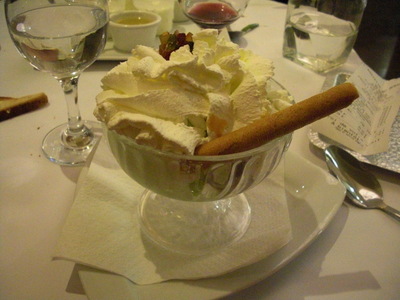 Dessert, David: He was delighted to find faisselle of fromage blanc "with three coulis" on the menu but was astonished to find, when it arrived, that he actually got three faisselles, one for each coulis (apricot, red fruit, and pear). But he ate all three anyway. In the photo, he had turned the first one out, between the apricot and red fruit coulis, and has set its little perforated plastic cup out of the way next to the pear coulis.
Dessert, David: He was delighted to find faisselle of fromage blanc "with three coulis" on the menu but was astonished to find, when it arrived, that he actually got three faisselles, one for each coulis (apricot, red fruit, and pear). But he ate all three anyway. In the photo, he had turned the first one out, between the apricot and red fruit coulis, and has set its little perforated plastic cup out of the way next to the pear coulis.
Dessert, me: Ice cream. I had the "Mediterranean cup," consisting of anise, lavender, and fresh mint ice creams topped with way too much whipped cream (an expression I never thought I'd find myself using; how can you have too much whipped cream?).
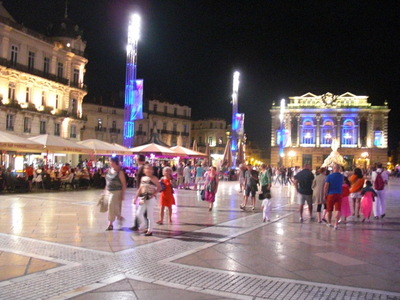 The evening was balmy, so we strolled around the place on our way back to the hotel. It's one of the largest (if not the largest) in France and is very popular. I got this shot on our way back (that's the Comédie—the Montpellier national opera—at the back right). My camera is amazing; even without flash, the scene looks brighter than it did in person.
The evening was balmy, so we strolled around the place on our way back to the hotel. It's one of the largest (if not the largest) in France and is very popular. I got this shot on our way back (that's the Comédie—the Montpellier national opera—at the back right). My camera is amazing; even without flash, the scene looks brighter than it did in person.
previous entry
List of Entries
next entry

 Breakfast at the Mercure was, indeed, more elaborate than at either Ibis Budget or full Ibis. And, fortunately, it was served in a separate dining room. The Germans had, in fact, come down in a body, and knowing that they would, and couldn't possibly all be accommodated in the Ibis Budget dining room, the management had partitioned off a section of the Mercure dining room for the overflow, and the breakfast clerk kept a sharp eye that none of them strayed around the partition to help himself from the Mercure buffet.
Breakfast at the Mercure was, indeed, more elaborate than at either Ibis Budget or full Ibis. And, fortunately, it was served in a separate dining room. The Germans had, in fact, come down in a body, and knowing that they would, and couldn't possibly all be accommodated in the Ibis Budget dining room, the management had partitioned off a section of the Mercure dining room for the overflow, and the breakfast clerk kept a sharp eye that none of them strayed around the partition to help himself from the Mercure buffet.
 Now, the viaduct of Millau. Where to begin. This is the view of it from my hotel window, slightly telephotoed. Before it was opened in December of 2004, thousands upon thousands of French vacationers driving south by one of the country's three major north-south routes had to pass through the little town of Millau. The freeway brought them to the northern edge of the Tarn valley (shown at the right, with one of the viaduct's pylons in the foreground) and carried them away again from the southern edge, but to get from one to the other, they all had to leave the freeway, drive down the steep slope into the little town, through it, and up the other side to rejoin the freeway (and then back again the other way when vacation was over). The traffic jams were horrendous; sometimes the wait was over five hours!
Now, the viaduct of Millau. Where to begin. This is the view of it from my hotel window, slightly telephotoed. Before it was opened in December of 2004, thousands upon thousands of French vacationers driving south by one of the country's three major north-south routes had to pass through the little town of Millau. The freeway brought them to the northern edge of the Tarn valley (shown at the right, with one of the viaduct's pylons in the foreground) and carried them away again from the southern edge, but to get from one to the other, they all had to leave the freeway, drive down the steep slope into the little town, through it, and up the other side to rejoin the freeway (and then back again the other way when vacation was over). The traffic jams were horrendous; sometimes the wait was over five hours!
 First, it's huge! These information panels are a little small in the photos, but I include them to show, at the left, the view from below of a pylon under construction with its dedicated tower crane, secured to it at intervals. The mechanism by which the crane could extend itself upward as the pylon grew was, to my mind, the second coolest thing about the whole project. I'm still thinking about whether I could actually describe it intelligibly to you, without the model they used on C'est pas sorcier. That panel also shows two views (one close up and one from farther back) of the pinacle (attachment point for the cables) being lifted into place above the top of one of the pylons.
First, it's huge! These information panels are a little small in the photos, but I include them to show, at the left, the view from below of a pylon under construction with its dedicated tower crane, secured to it at intervals. The mechanism by which the crane could extend itself upward as the pylon grew was, to my mind, the second coolest thing about the whole project. I'm still thinking about whether I could actually describe it intelligibly to you, without the model they used on C'est pas sorcier. That panel also shows two views (one close up and one from farther back) of the pinacle (attachment point for the cables) being lifted into place above the top of one of the pylons. 
 After thoroughly exploring the indoor exhibits (no photography allowed) and watching a movie montage of scenes from the contruction process, we followed our guide out into the outdoor area. Here, at left and right, are views of the footprint of a pylon, laid out so that you can walk through it and get an idea of its scale. In the right-hand view, at the right-hand side, they've left a window in the concrete so that you can see the latticework of rebar embedded in the wall. The area inside the foot of the largest pylon (#2, the tallest ever built) is the size of a tennis court.
After thoroughly exploring the indoor exhibits (no photography allowed) and watching a movie montage of scenes from the contruction process, we followed our guide out into the outdoor area. Here, at left and right, are views of the footprint of a pylon, laid out so that you can walk through it and get an idea of its scale. In the right-hand view, at the right-hand side, they've left a window in the concrete so that you can see the latticework of rebar embedded in the wall. The area inside the foot of the largest pylon (#2, the tallest ever built) is the size of a tennis court.
 The coolest thing about the construction, though, was the way in which the roadbed was laid. Once the pylons were built (all seven were built simultaneously, to save time), additional, temporary metal pylons (the largest ever built) were erected between them to support the roadbed across the long spans until the suspension cables were installed. The one place where they couldn't put a temporary pylon was between pylons 2 and 3, because it would have had to stand in the river, so that was the point at which the two ends, advancing from opposite sides of the valley, had to meet, in mid air. But the truly cool thing is how the two ends were advanced. Eiffage is too good an employer to ask its welders to work out over the void, attaching each roadbed section to the previous projecting one. Instead, they attached each new section at the landward end, on terra firma, then pushed the entire roadbed so far assembled out over the void before attaching the next section at the landward end!
The coolest thing about the construction, though, was the way in which the roadbed was laid. Once the pylons were built (all seven were built simultaneously, to save time), additional, temporary metal pylons (the largest ever built) were erected between them to support the roadbed across the long spans until the suspension cables were installed. The one place where they couldn't put a temporary pylon was between pylons 2 and 3, because it would have had to stand in the river, so that was the point at which the two ends, advancing from opposite sides of the valley, had to meet, in mid air. But the truly cool thing is how the two ends were advanced. Eiffage is too good an employer to ask its welders to work out over the void, attaching each roadbed section to the previous projecting one. Instead, they attached each new section at the landward end, on terra firma, then pushed the entire roadbed so far assembled out over the void before attaching the next section at the landward end!
 We were, at this point, thoroughly wowed and mindboggled, and it was time for lunch. Our drive back to Millau was complicated (as was our trip out of it, earlier) by a huge street festival (celebrating the bicycle) that was occupying the town's central street rotary, a couple of blocks from our hotel, which (of course) the GPS didn't know about. To get out of town, we'd bushwhacked northward to the river and crossed it before paying any attention to the GPS, which at that point had recalculated the route that didn't lead through town. Going back, we just retraced our route, then turned cautiously inward toward the middle of things, but not too far, looking for parking (helpfully marked on our little paper city map). A few minutes' walking led us to the Place Maréchal Foch (Foch, pronounced "fawsh," is another of those guys with a something named after him in every town) and this little pizzeria under a historic arcade.
We were, at this point, thoroughly wowed and mindboggled, and it was time for lunch. Our drive back to Millau was complicated (as was our trip out of it, earlier) by a huge street festival (celebrating the bicycle) that was occupying the town's central street rotary, a couple of blocks from our hotel, which (of course) the GPS didn't know about. To get out of town, we'd bushwhacked northward to the river and crossed it before paying any attention to the GPS, which at that point had recalculated the route that didn't lead through town. Going back, we just retraced our route, then turned cautiously inward toward the middle of things, but not too far, looking for parking (helpfully marked on our little paper city map). A few minutes' walking led us to the Place Maréchal Foch (Foch, pronounced "fawsh," is another of those guys with a something named after him in every town) and this little pizzeria under a historic arcade. 

 Our work in Millau was almost done (though I would have liked to visit the museum of glove making). All that remained was actually to drive over the viaduct! That's not as easy as it sounds, from Millau. You have to drive a ways north of town to pick up the freeway, and the next chance to get on or off it is much farther south of town. We therefore set the GPS to take us to Cahors, as the easiest way to get it to direct us to the next chance to get onto the freeway. (It worked like a charm, although later, when we wanted to go to Montpellier, we had a little trouble pursuading it that we didn't want to go there via Cahors.)
Our work in Millau was almost done (though I would have liked to visit the museum of glove making). All that remained was actually to drive over the viaduct! That's not as easy as it sounds, from Millau. You have to drive a ways north of town to pick up the freeway, and the next chance to get on or off it is much farther south of town. We therefore set the GPS to take us to Cahors, as the easiest way to get it to direct us to the next chance to get onto the freeway. (It worked like a charm, although later, when we wanted to go to Montpellier, we had a little trouble pursuading it that we didn't want to go there via Cahors.) 
 When we signed up for our Roquefort cave tour, we chatted with the cashier, and when he heard we were on our way to Montpellier via Millau, he warmly recommended a fortified village built by the Knights Templar and called La Couvertoirade. Just off the freeway, he said, and even told us the exit number.
When we signed up for our Roquefort cave tour, we chatted with the cashier, and when he heard we were on our way to Montpellier via Millau, he warmly recommended a fortified village built by the Knights Templar and called La Couvertoirade. Just off the freeway, he said, and even told us the exit number.
 After the movie, we climbed the tower above the Office de Tourisme (the light-colored square one nearest the camera in the model; the little archway at the bottom of it is the gate we entered through, and the Office de Tourisme on the right just inside) to reach the ramparts. You can't walk all the way around, but you can do a little more than half of the distance.
After the movie, we climbed the tower above the Office de Tourisme (the light-colored square one nearest the camera in the model; the little archway at the bottom of it is the gate we entered through, and the Office de Tourisme on the right just inside) to reach the ramparts. You can't walk all the way around, but you can do a little more than half of the distance.
 The occupant of one house was cultivating the spectacular terraced garden in adjacent ruins. I think it was actually the garden of the spinner/weaver from the movie, who mentioned that, when she washed raw fleeces, she reused the water several times and then watered her garden with it.
The occupant of one house was cultivating the spectacular terraced garden in adjacent ruins. I think it was actually the garden of the spinner/weaver from the movie, who mentioned that, when she washed raw fleeces, she reused the water several times and then watered her garden with it.


 Main course, David: Excellent veal cutlet with "forestière" (i.e., cream and mushroom) sauce, fries, quite good green beans, and a roasted tomato.
Main course, David: Excellent veal cutlet with "forestière" (i.e., cream and mushroom) sauce, fries, quite good green beans, and a roasted tomato.
 Dessert, David: He was delighted to find faisselle of fromage blanc "with three coulis" on the menu but was astonished to find, when it arrived, that he actually got three faisselles, one for each coulis (apricot, red fruit, and pear). But he ate all three anyway. In the photo, he had turned the first one out, between the apricot and red fruit coulis, and has set its little perforated plastic cup out of the way next to the pear coulis.
Dessert, David: He was delighted to find faisselle of fromage blanc "with three coulis" on the menu but was astonished to find, when it arrived, that he actually got three faisselles, one for each coulis (apricot, red fruit, and pear). But he ate all three anyway. In the photo, he had turned the first one out, between the apricot and red fruit coulis, and has set its little perforated plastic cup out of the way next to the pear coulis. The evening was balmy, so we strolled around the place on our way back to the hotel. It's one of the largest (if not the largest) in France and is very popular. I got this shot on our way back (that's the Comédie—the Montpellier national opera—at the back right). My camera is amazing; even without flash, the scene looks brighter than it did in person.
The evening was balmy, so we strolled around the place on our way back to the hotel. It's one of the largest (if not the largest) in France and is very popular. I got this shot on our way back (that's the Comédie—the Montpellier national opera—at the back right). My camera is amazing; even without flash, the scene looks brighter than it did in person.